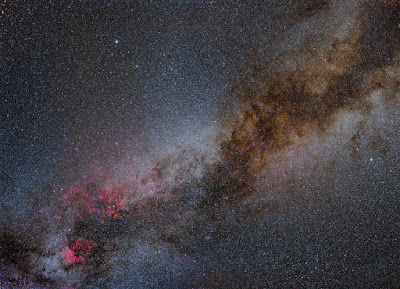This past April I came across a deal I could not refuse. I added a second body and two lenses. The lenses were duplicates to what I owned, but an idea floated around in my head. The recent addition of a new german equatorial mount made it possible to configure many possible arrangement of cameras and telescopes. I purchased the necessary Losmandy plates and gathered an old Televue Ranger to be used as a guide scope.
Two Pentax bodies and matching 105's make a formidable team. Simultaneously exposing two frames will make lighter duty of combined framed images and mosaics.
 |
| The Meade LXD75 and secondary systems holding the two Pentax 67's and guide scope |
I do not believe this has ever been done or if it is workable. I believe it is. I have the freedom to use lens pairs or two different focal lengths if desired. It will make mosaics much easier.
 |
| The two Pentax 67's with 105mm f/2.4 lenses |
The image below is an example of two frames using the 105mm. The two frames were exposed sequentially. The new mounting and camera configuration will make this a "one shot" effort!
 |
| A mosaic of two frames with the 105mm f/2.4 lenses |
This image was done with two frames using the 165mm f/2.8. This is another possibility using the two camera setup.
 |
| A mosaic of two frames with the 165mm f/2.8 |
So planning continues. I will give it a try later in the summer. Skies darken very late in June and time to shoot is very limited. I prefer late August to begin film work. Skies darken early enough to get a good session in prior to midnight.
When the year started I was looking for direction as to where I would go in my efforts. The digital workflow has made me lazy and I was never 100% happy with the colors and textures. It appears I will still work with film for some time to come.
There are plenty of digital astrophotographers out there. They do good work. This is my story. I'll tell it a bit differently.
